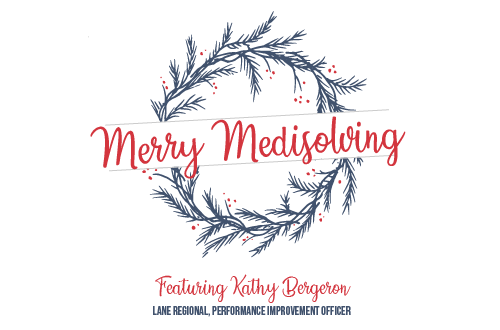Merry Medisolving: Featuring Lane Regional

What’s the key to improving the quality of care at your hospital? Lane Regional knows first-hand what it takes to make significant performance improvements.
In this article, we feature Kathy Bergeron who is tasked with performance improvement at Lane Regional. With a reduced Medicare reimbursement on the line, Kathy and her team pay close attention to their quality performance.
 |
Name: Kathy Bergeron Job Title: Performance Improvement Officer Hospital: Lane Regional |
Here, she shares how a change in Lane’s performance improvement efforts led them to a readmission rate decrease from 9.09% to 7.54% and how she used data to prevent surgery complications.
As a performance improvement officer, what specific performance improvements do you strive to achieve within the hospital?
It’s always to achieve our mission at Lane, which is to provide exceptional health care to every patient, every time. We also strive for zero harm to our patients and employees.
Performance is now tied to Medicare reimbursement…which wasn’t the case when you started this role 20 years ago. How have your performance efforts changed since then?
With pay for performance, there is definitely a greater emphasis on quality. Quality is not only the right thing to do for our patients, but now it is also the right thing for the bottom line. When your denominators are low for a certain indicator, one mistake can have a negative effect on our reimbursement.
And do you think that having these government regulations in place now has been beneficial or burdensome to your hospital?
I think it has resulted in some positive outcomes for Lane. It has helped direct our attention to certain areas that we may not have picked to monitor continuously if we weren’t required to do so.
Interesting. Can you give me an example of an area that you’ve started to monitor more continuously over the years?
Readmissions has been a big one for us. By keeping a close eye on it and taking action quickly, we’ve been able to reduce our readmissions rates over the past two years. In 2016, we were at a 9.09% readmission rate and now we are down to 7.54%.
How did you go about updating your process and reducing your readmission rate?
Being able to stay on top of it has been huge for us. We use a two-step approach.
First, our social workers in our case management department use the LACE report that Medisolv helped us build through their RAPID software. [The LACE report uses predictive analytics to flag patients with a higher risk of readmission.] The report is emailed to our social workers every day so that they can identify who is at risk to be readmitted. Once a patient is identified, we can work toward addressing the issues before the patient is discharged and ensure that we’ve done as many things as possible to help prevent a readmission.
Then on the quality end, we use Medisolv’s ENCOR Dashboards, which allows me to track and review our readmissions in a timelier manner so that we can identify trends quickly and take action immediately. The software also provides assistance to review the accuracy of coding to ensure that all risk factors are captured.
It sounds like your performance improvement efforts have really evolved over the years.
It has! Our process before was very labor intensive. I used to build reports through our EHR system, but they weren’t really accurate. I’m not an IT person, so I didn’t always have the necessary inclusions and exclusions built into the reports.
If I wanted to sort it by insurance groups, I would have to build different reports to pull all the information I needed. It was time consuming and a bit complicated.
Now we can take action in real time. And it’s not just readmissions, there are a lot of other indicators that we’ve been able to stay on top of and improve. Medisolv covers almost every Value-Based Purchasing, Hospital-Acquired Condition and readmission indicator.
That’s so great. What other improvements have you made?
Through the total hip and knee replacement report that Jorge Machado from Medisolv built for us, we were able to identify two patients who had developed post-op pneumonia after a total hip surgery. Once I saw that, I met with our respiratory department and they were able to change what they were doing with the patients post operatically. Since that intervention change, we’ve had no more post-operative pneumonia.
If it wasn’t for that report, I would not have had a way to collect that data. It’s so complicated—I just do not have the technical skills to build that report manually. Now I can look at this report every month rather than having to wait for the Medicare report to come out once a year.
Just by having this data quickly, we were able to intervene with our respiratory department and change practices to improve the care of our patients.
So it sounds like having this more systematic process in place has helped strengthen your communication and collaboration with other departments, too?
Yes. The great thing about having the dashboard is that I can get to the data quicker. So I actually take the data from the dashboards and post it on the huddle boards that we have in each department to highlight educational information about our performance. We really try to keep everyone informed about what is going on.
To what do you attribute all your performance improvement success over the years?
We just have really simplified our process, and there’s no lag time like there used to be to get our data. Being able to see our data—and knowing that it’s accurate—allows us to take the necessary action to improve the care for our patients, which is the ultimate mission and goal for Lane.





Comments